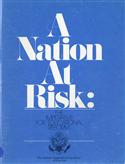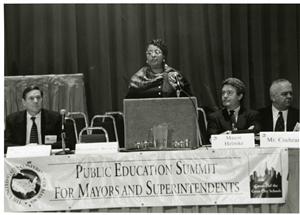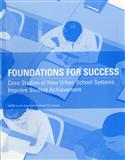- Council of the Great City Schools
- History, Page 2
-
History of the Council- continued
In 1982, the Council's membershp skyrocketed, growing to 37 districts almost overnight. President Ronald Reagan was in office and during his administration federal support for urban education was under attack. Accountability
Accountability
In 1983, the U.S. Department of Education’s “Nation at Risk” report brought the issue of accountability to the forefront. The report, and the National Governors Association’s 1986 “Time of Results” report, were wake-up calls to Americans about the need to improve public education.Urban School Goals
To respond to the growing concerns about American education, President George Bush in 1989 and the National Governors Association formulated six national education goals. The Council also sprang into action to develop a parallel set of goals to reflect the specific needs of urban schools and students. Then in 1991, it held an urban education summit, which officially adopted the goals.
A year later, the coalition released its first-ever “report card” on the state of urban education in America, which gave indicators of urban school progress toward achieving the National Urban Education Goals.
New Leadership
Leadership of the Council changed in 1992, when Michael Casserly took the helm after the long-time tenure of Samuel Husk, who had been executive director for 17 years. Under Casserly, the Council has unified urban schools nationwide around a vision of reform and improvement. National task forces have been launched to focus on achievement gaps, leadership and governance, finance, professional development and bilingual education. Milestones
Milestones
In 1997, the Council convened what news reports called a “landmark” meeting between big-city mayors and urban school superintendents. The historic summit resulted in a pledge of cooperation and a call for further dialogue between schools and government.
A few years later in 2000, the Council approached the National Assessment Governing Board (NAGB) to request a trial National Assessment of Educational Progress (NAEP) for big-city school systems that wanted to volunteer for the rigorous national test."The Council and its member districts are fully committed to the standards movement, yet we have no way to determine our status or our progress on those standards," argued Casserly before the governing board."This is a courageous act by the urban schools. It's a sea change," said then-NAGB chairman Mark Musick in Education Week. NAGB supported the idea, and subsequently the urban NAEP was launched.
Major Research
In 2001, the Council released the first compilation of how the nation’s large city school systems are performing on the academic goals and standards set by the individual states for their children. It launched the annual Beating the Odds: A City-by-City Analysis of Reading and Math Performance and Achievement Gaps on State Assessments.
A year later, the Council released a first-of-its-kind study with research group MDRC called Foundations for Success: Case Studies of How Urban School Systems Improve Student Achievement, which looks at the similarities among urban school systems that are boosting performance citywide and contrasts their practices with systems that have not seen major gains.
Today’s Council
The Council continues to grow, with 16 big-city school districts joining the coalition since the organization’s 40th anniversary in 1996, when it had some 50 members. It currently is spearheading efforts to boost academic performance and strengthen management and operations in America’s urban school districts, as well as challenging inequitable state financing systems and improving the public’s image of urban education.1 | 2
Media Contact:
Contact Name
Contact@email.com
(000) 000-0000
Contact Name
Contact@email.com
(000) 000-0000
Contact Name
Contact@email.com
(000) 000-0000
Media Contact:
Contact Name
Contact@email.com
(000) 000-0000
Contact Name
Contact@email.com
(000) 000-0000
Contact Name
Contact@email.com
(000) 000-0000

